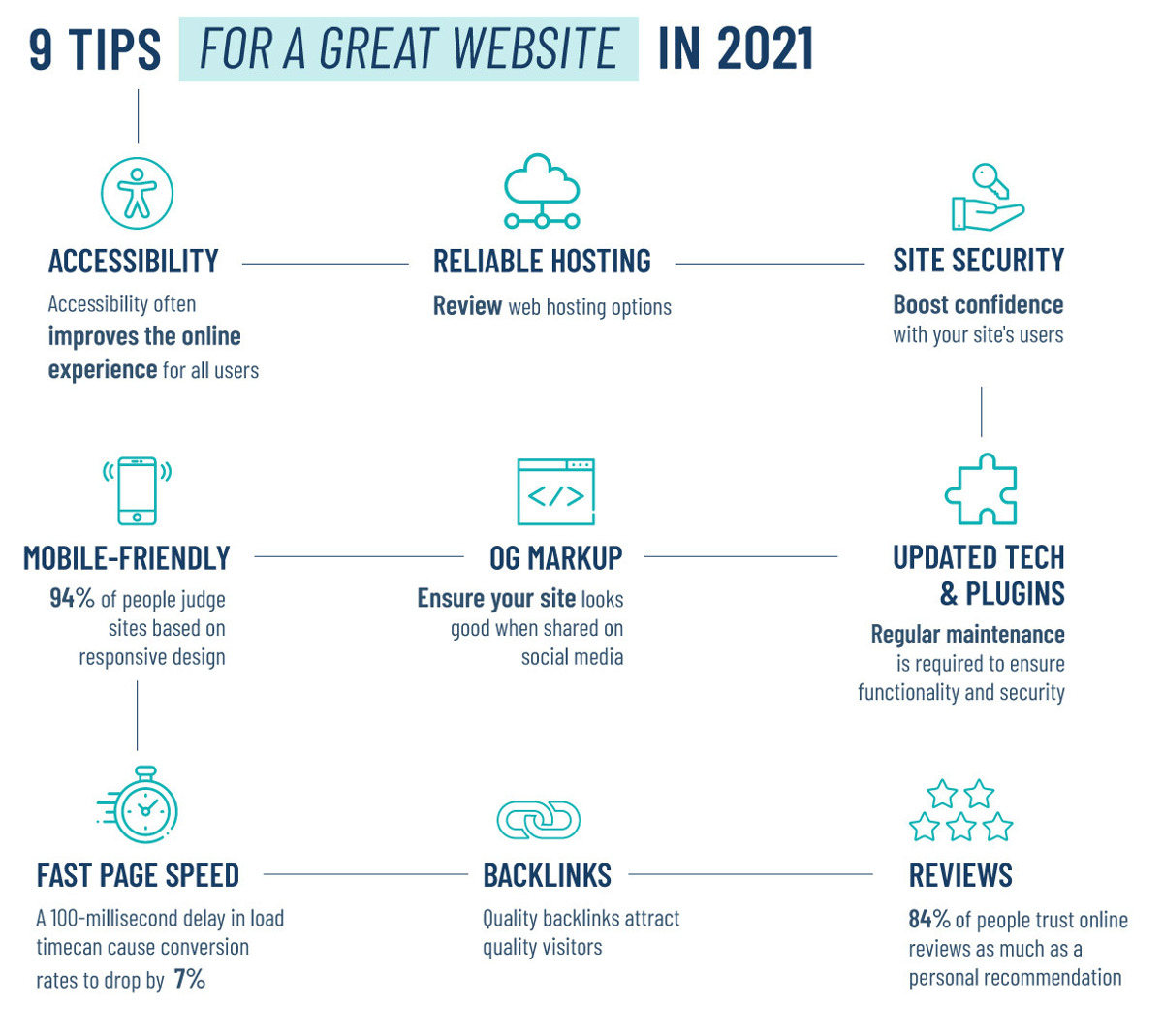Be sure to check out our recommendations from 2020 — they’re still relevant!
As you kick off your website and marketing plans for 2021, it’s a good idea to identify your biggest pain points and analyze your analytics to help define your goals. And while everyone’s goals may differ slightly, we bet your site could benefit from implementing (or improving) the following:
Accessibility
It has always been a good idea to make your website accessible to people of all abilities, but it’s the type of task that tends to get back-burnered. “It looks fine to me!” we tell ourselves, forgetting that not everyone will have the same experience on the website as us. In addition to helping your website visitors have a better experience, it’s also quickly becoming the standard across the web—you don’t want to be left out and you don’t want to risk a lawsuit.
It’s good rule of thumb to aim for AA-level compliance with the WCAG guidelines. You (or an expert) should conduct an audit of your site, listing out all the changes that need to be made to improve accessibility, then run through the site and make those changes (or enlist the help of a developer). Our article on ADA compliance has more information if you’d like to take a deeper dive.
Reliable Hosting
How many times has your site been down in the past year? How promptly did your hosting provider notify you of the issue and help you resolve it? If your site was down often or for long periods of time, and if your provider’s customer service is lacking, you might want to take another look at your hosting situation. If you’re wondering whether it’s time to make the switch, you’ll want to research the different types of web hosting to see what is the best fit for your needs.
Site Security
As each year passes, it seems that spammers and hackers get better, stronger, and faster. Which is bad news for your website. You’ll want to be sure you have the following:
Form Spam Protection. If your site has contact forms (which are a great way for website visitors to reach you) then your site probably also has contact form spam (which is a great way for spammers to annoy you). While you can always just delete the spam emails, it keeps you from focusing on your business. There are a few different solutions that work (with varying pros and cons), but our current preference on WordPress sites is the Stop Spammers plugin. As with any plugin, be sure to read the reviews and test it out on a dev site before installing it on your live site. Not every plugin is the right fit for every site, but so far we’ve seen this plugin help block spam without inadvertently blocking legitimate submissions.
SSL certificate. When your SSL certificate is in place, your website visitors will see the lock icon in their browser bar, which allows them to browse your site with confidence in your site’s security. It also helps your site avoid Google’s “unsafe website” warning, which can negatively impact your site’s rankings and your visitors’ experience. You should be able to purchase an SSL certificate at the same place you registered your domain name, and they can usually help you install it (sometimes for a nominal fee) or you can search their help articles for instructions on how to do it.

Updated Technology and Plugins
Once a website is built, it needs regular maintenance to ensure functionality and security. It’s a good idea to set your site up with a service like ManageWP to help keep an eye on things like security, updates, page speed performance, and uptime monitoring. You’ll want to make frequent backups (we recommend daily), and always run a fresh backup before making updates to your site, including updating plugins, themes, and WordPress core software.
Two things in particular to stay on top of this year:
1. Updating your site’s jQuery version
2. Updating your site’s PHP version to the most recent version (7.4 as of this article’s posting)
OG Markup
In addition to thinking of how website visitors interact on your site, it’s important to consider how they will interact with your website from other sites. For example, if someone shares an article from your site on social media, how does it display? Does it automatically pull in an optimized image, explanatory title, and useful description? Or does it randomly pull an image and text from the page? By properly setting up your OG (open graph) markup, you can better control how links from your website display on social media.
Responsive/Mobile-Friendly Design
Just over 50% of internet traffic comes from mobile devices (according to Statista), and if your site doesn’t perform well for those users, you could miss out on all that traffic. More people than ever are browsing, researching, shopping, and engaging with websites on their phones—make sure your site works just as well for mobile users as desktop.
Fast Page Speed
Ensuring your website loads quickly is extremely important, in large part due to the increase in mobile traffic. More people may be viewing your site on a slow connection with a small screen—if it takes a long time for the content to load, they’ll leave your site for a faster site. Google takes page speed into consideration as a ranking factor, so if your site is slower than those of your competitors, you could be pushed down in the rankings. Additionally, Google now includes Core Web Vitals as an important factor in their ranking algorithm, which is more in-depth than simple page speed; it considers (among other things) how long a page takes to load, the interactivity, and the visual stability of the page contents.
Quality Backlinks
One often-overlooked search engine ranking factor is the number (and quality) of other sites linking back to you. It’s usually overlooked because either people don’t understand its importance or they don’t have the time to do anything about it. Both are valid reasons! But know this: While Google takes into consideration everything on your own site when determining where to rank you, it also takes in account what other sites think about you. And one of the best ways for them to determine that is if lots of high-quality sites have linked to your site. It signals to Google that these guys vouch for you and your content; essentially, that your site is about what you’re saying it’s about. It can take time to identify sites that might link to yours and to contact each one of them individually, but the payoff can be huge.
Positive Reviews
Word-of-mouth is a timeless technique for driving customers to your business. And one of the best ways to do that is by getting reviews online. In fact, 82% of consumers read reviews for local businesses and people read an average of 10 online reviews before trusting a local business. Having a large number of positive reviews signals to potential customers that your business/products/services are good. This social proof can convince someone who’s on the fence to take a chance on you.
Depending on the nature of your organization, you might seek reviews on Google My Business, Facebook, and/or Yelp. Other niche sites could also work, but don’t spread yourself too thin! It’s better to aim for a high number of positive reviews rather than a scattergun approach of a few reviews all over the place. Be sure to display any particularly good testimonials on your website and make it easy for people to read all your reviews by linking to the site(s) (e.g. Google My Business) where you have the most reviews.
How does your website measure up so far in 2021? Does it have some or all of these things, or could it use a little sprucing up? If you’d like help, drop us a line. We’d be happy to get your site ready for this year.
